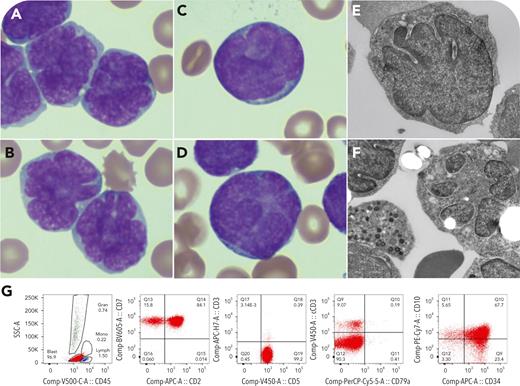A 21-year-old man presented with a high white blood cell count (469 × 103 cells per μL) and a mediastinal mass. Peripheral smear revealed 95% blasts, with most having variably indented nuclei and some displaying distinct flower petal nuclei, fine chromatin, and prominent nucleoli (panel A, hematoxylin and eosin stain [H&E], original magnification ×100; panel B, H&E, original magnification ×100; panel C, H&E, original magnification ×100; panel D, H&E, original magnification ×100; blasts with cyanthiform nuclei; panel E, electron microscopy, original magnification ×5000; panel F, electron microscopy, original magnification ×4000; electron microscopy showing blasts with irregular nuclear contours resembling flower petals). Flow cytometry revealed an abnormal cell population, positive for CD2, cytoplasmic CD3, CD5, CD7, CD10, CD13, CD33, CD34, and dim terminal deoxynucleotidyl transferase and negative for surface CD3, CD8, CD19, CD20, CD79a, CD117, and myeloperoxidase (panel G). Immunohistochemical stain CD1a was negative in the neoplastic cells (not shown). Chromosome analysis of bone marrow aspirate revealed a complex karyotype: 48-50,XY,t(10;14)(q24;q11.2),del(16)(q11.2),+2-4mar[19]/46,XY[1]. Fluorescence in situ hybridization analysis suggested TLX1::TCR A/D rearrangement.
According to the fifth edition of the World Health Organization Classification of Hematolymphoid Tumors, this is consistent with near early T-precursor lymphoblastic leukemia/lymphoma (near ETP-ALL). A detailed morphological evaluation, combined with thorough immunophenotyping by flow cytometry, was crucial for accurately diagnosing near ETP-ALL and preventing its misdiagnosis as adult T-cell leukemia/lymphoma.
For additional images, visit the ASH Image Bank, a reference and teaching tool that is continually updated with new atlas and case study images. For more information, visit https://imagebank.hematology.org.


This feature is available to Subscribers Only
Sign In or Create an Account Close Modal